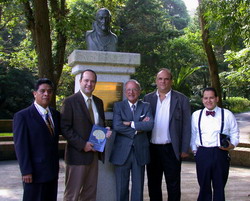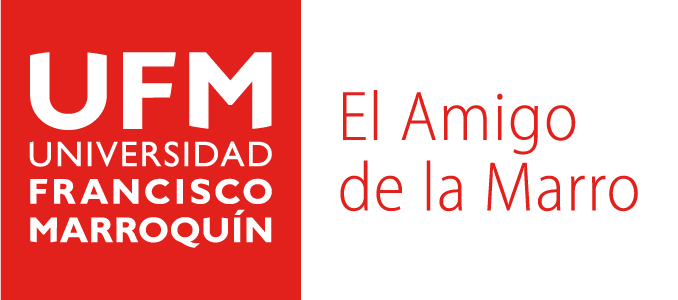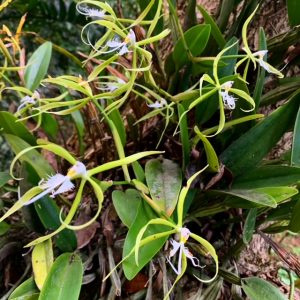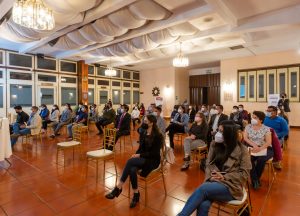 |
| Julio César De Leon, Giancarlo Ibárgüen S., Joaquin Fuster; Ricardo Castillo A. and Juan José Ramírez |
The Mysteries of the sensorial order and the evolution of the cerebral cortex, related to development of the mind and civilization, have been some of the themes exposed by Dr. Joaquín Fuster during his visit to the UFM in a series of conferences and specialized reunions.
At the UFM he lectured The Sensorial Order: the Hayekian contribution to the current neuropsychologic models, at the Milton Friedman Auditorium last Wednesday August 16th 2006 (see the conference here); he also spoke during a Socratic dialogue with the members of the UFM’s Philosophy Seminar on The Philogenetic evolution of the cerebral cortex: the relations between the cortex development and human civilization development.
The next day he lectured psychology professors and students on How to understand the mystery of the brain and its implications for spontaneous human behavior at the Friedrich A. Hayek auditorium. Next Friday August 18th, at the UFM’s Medicine School he will lecture on The Contribution of cognitive Neuroscience to the treatment of mental disorders, specially those that affect the superior cognitive functions.
Joaquín Fuster teaches psychiatry and bioconduct sciences at the Neuropsychiatric Institute and at the Brain Research Institute of the University of California at Los Angeles.
His findings allow a better understanding of the cognitive disorders and the base of many neurological and psychiatric disorders like cerebral traumas, seizures, Alzheimer and schizophrenic dementia. His research is centered on the study of cortical mechanisms and cognitive functions. The objective of his studies is to attain a better understanding of the cerebral cortex malfunctions in neurological and mental diseases that impair cognition. Such understanding leads to more effective treatments.
In 1958 Fuster gave the first evidence that the cerebral reticular activation system, a nervous region that lets us wake up, modules selectively the visual attention (Science, 1958). Since then, he has made many significant scientific contributions to his field. For example, in 1971 he discovered the first memory cells found in primates (Science, 1971; and Neurophysiol, 1973).
In the 90’s, he and his colleagues discovered and analyzed the properties of memory cells for tactile tasks in the somatosensorial cortex (PNAS, 1996); then they showed that neurons from the prefrontal cortex integrate information in two different sensorial forms, sound and visual, through time (Nature, 2000).
As a result of his discoveries, Fuster has developed and proven hypothesis where the three memory forms (short term, working and long term) share the same cortical networks.
In a recent book, Cortex and Mind: Unifying Cognition, Fuster expanded his concepts beyond memory towards other cognitive functions such as perception, attention, intelligence and language. He says that all the cognitive functions are based in nervous transactions in and between neuronal networks of cognitive representation.
During his first day at the UFM, Fuster met with UFM’s President Giancarlo Ibárgüen S.; with the general secretary, Ricardo Castillo A.; and the Director of Social Philosophy, Julio César De León Barbero; and the professors Juan José Ramírez and Julio Cole. Then he visited the Popol Vuh Museum of this house of studies.
Photos of the conference on social order,
here.
Photos of the Psychology conference,
here.
Photos of the Medicine conference,
here.
More photos,
here.
Recientes
- 1
- 2
- 3
- …
- 1.541
- Siguiente »



